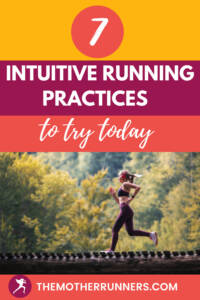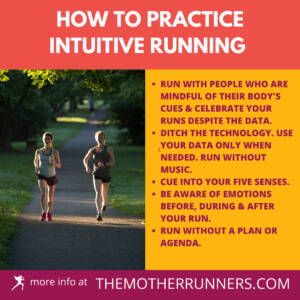I must admit something. I am terrible at being an intuitive runner. You know, someone who connects with nature and their body, and finds inner peace while running. Someone who uses their run time to slow down instead of speed up when life already moves too fast.
No, what I do is kind of the opposite of intuitive running.
If I am on a familiar path during daylight with lots of people around, I am zoned OUT. I have my music turned UP. Running hard while listening to good tunes just feels so empowering. If I am doing a workout or long run, I am barely paying attention to what is around me. And I am telling my body to SHUT UP.

I had one of my athletes tell me the other day that she had to convince her running club that I was nice—because when they would see me, my face was always VERY serious. Admittedly, when I am in a marathon cycle, I take my running very seriously. Now, this isn’t all the time, but this is a lot of the time.
Related: Runner Safety Tips & Best Personal Safety Products
And I realized, I needed to stop.
This summer, I did a lot of early morning runs before my kids got up and my husband left for work. I didn’t listen to music, ran slow–letting my body and mind ease into the day. I watched the colors of the sunrise spill over the Tennessee river, listened to the birds chirp and trees rustle in the breeze, and felt my body move through the air and over the gravel. It was like a meditation. And I returned a lot calmer and content with the day and my overall place in this life.
It was a much different mood than when I am out running fast and hard with Post Malone cranked up high. I mean those runs do have their place, but not every day.

What I was doing was a form of intuitive running. You may have heard about intuitive running and wondered what it is. Is it the same as intuitive eating? How do you practice is? And is it right for you?
I got with Sara Hayes, founder of Mindful Miles, a coaching and running community focused on using running to empower you, to answer all your questions about intuitive running.
(Hear more from Sara in my interview with her on The Passionate Runner podcast!).
In this article, I will cover:
- What is intuitive running?
- What are the benefits of being an intuitive runner?
- Who is intuitive running best for? Who can benefit the most?
- And 7 intuitive running practices for you to try on your next run
Let’s go!
Related: How to Find Your “Why” In Running
What is intuitive running?
Intuitive running, like the practice of intuitive eating, is about recognizing, listening to, and acting upon your body’s cues. These cues, when responded to, will allow you the freedom to listen to your body first before other external factors such as your watch, coach, or fellow runners.

The goal of intuitive running is to become so in tune with your body that you will be able to adjust your training plan whenever you need based not on what someone or something else is telling you, but on what your body needs at that very moment. This can save you from injury, burnout, and restore joy to running.
Intuitive running is a fairly new approach and requires practice to perfect.
It can be argued that the great ultra runner Courtney Dauwalter practices intuitive running. She doesn’t have a coach or follow a training plan. She goes out and runs what she feels like for the day. And it seems to be working quite nicely for her. This summer she set the course record for Western States 100 and then set another course record just three weeks later in the Hardrock 100!
Related: How to Start Running: A Complete Guide
Why is intuitive running beneficial?
Like most areas of life, when we become too dependent on technology or the opinions of others, we run the risk of losing our sense of autonomy. Each of us has our own individual body that talks to us through specific cues each and every day and is ours to either take care of or neglect. While we all have similar anatomy, each person’s needs are specific to our age, gender, lifestyle, etc.
Related: Should You Ditch Your GPS Watch?
The overarching benefit of being an intuitive runner as explained by Sara is that intuitive running “… promotes a sense of freedom and self-discovery in running, allowing you to focus on your own individual experience rather than external metrics like speed or distance.”
Sara praises intuitive running for being a conduit to rediscovering the joy and freedom of movement. Like a kid coming in from the exhilarating recreation of recess, intuitive running helps you tap into the feeling of fun and play that movement generates rather than hyperfocusing on metrics. “These metrics are helpful in small doses,” Sara says, “but they’re not going to bring you joy.”
This intuitive approach completely appeals to me as a runner who can feel boxed in by an inflexible training schedule and goal paces. It can be a release and a form of meditation (which countless studies have shown the benefits of).
Who needs to practice intuitive running?
Everyone could benefit from the practice of intuitive movement, but if you’re struggling specifically with the following, Sara recommends starting to integrate the intuitive running practice into your weekly mileage:
- Body image, confidence, self-acceptance
- Comparison (to self or others)
- Finding joy from running, or
- Wanting to challenge yourself without overdoing it
Related: How to Get Your Running Motivation Back
How does intuitive running amplify the benefits of running?
If you’ve been running for more than a moment, you’ve most likely had one experience (or a hundred) of some “niggling” pain on a training run. Maybe it’s your ankle, your hip, or knee. Maybe it’s a stitch in your side or a tense lower back.
Whatever it may be, you likely have made one of two decisions:
1) chosen to “push through the pain” and dismiss your body’s cues entirely, or
2) asked yourself more questions to determine if continuing to run will be helpful or harmful.
Related: When to Skip a Run & How to Adjust Your Schedule
An intuitive runner often takes the latter path. It is the practice of being able to not only listen to your body’s cues, but also knowing how to respond to them in the way in which will benefit you the most. Intuitive running will not only enhance your overall running experience, but will also reduce your risk of injury, and promote a more enjoyable and sustainable approach to the sport.

“It makes the excitement of running so much more potent,” Sara explains. “You develop an appreciation for the bad runs, the good runs feel so much brighter, and you develop a true understanding of why rest is so important. Intuitive Running reminds you that you’re not out here doing this for nothing. The ripple effect we see from showing up for ourselves makes us show up everywhere else in our life with that same level of pride and respect.”
Like Sara asserts, intuitive running has the power to improve performance and positively impact our lives as humans. What do you need and when do you need it?
These are the questions intuitive runners ask. A mindful runner notices not only when their form is deteriorating and they need to adjust, but also when dropping down their weekly mileage is necessary because the season they are in requires more of them.
Related: How to Make Running a Habit
The Fundamentals of Intuitive Running
There are three simple fundamentals that Sara promotes and encourages at Mindful Miles:
Find your community.
Discover and foster a community that is also learning and practicing intuitive running. These don’t necessarily need to be people who know the “buzzwords” or “specific techniques” of intuitive running, but rather are simply on the same page about running for the sake of the joy and freedom of it all. These are people who will not pressure you to ignore your body’s cues, but rather celebrate every single individual accomplishment of yours no matter how different from their own.
Practice body awareness.

Ask yourself, when heading out for a run, how you feel. Start to become mindful of your emotions: are you excited, dreading it, or feeling neutral? Give yourself 10 minutes on a run to determine if these feelings stay or change. The answers will often tell you something about your body and its state of need
Limit technology.
Limiting use of a phone, music, watch, etc. out on a run will help you become more focused and attuned to your body and your surroundings. Expect this to be the most difficult part of practicing intuitive running.
“For those of us that are training for more specific goals (marathon, time goal, etc.) tech is helpful and arguably necessary.” Sara says. “There is a world in which they can coexist, but the work is on you to determine what that means.” Sara suggests limiting technology to areas that will benefit you the most.
For example: if you’re struggling to run at an easy pace, perhaps a watch will help you stay in the correct heart rate zone, or if you’re needing an extra boost for speed training, a high-tempo song may help you to kick it into high gear. At the end of the day, though, Sara encourages us to keep in mind: “Data can help but, remember, people were breaking records long before GPS watches existed. You don’t need it.”
Related: How Running Makes You a Better Mom
7 Easy Intuitive Running Practices to Try on Your Next Run
1. Tune into your 5 senses.
On your next run, skip the music or podcast and tune into your surroundings. As you run, go through your five senses as slowly or as quickly as you feel: “What sounds do I hear?” (list them) “What do I feel?” (list what you feel) “What do I see?” (list what you see), etc.
2. Run without a plan.
When you are struggling to be in the mood to run this week, pick a route you know well and go on a run without your watch or any specific plan, focusing only on how you feel. Don’t worry about pace; don’t worry about distance; just run!
3. Run with a friend.
Meet up with a friend in a new location, perhaps with a view, and take time to just simply appreciate all that you see and the company that you are with.
4. Go for a gratitude run.
On one of your easy runs, spend any extra mental energy you have just thinking about all the gratitude you have for this sport, your body, and the people in your life who support you.
5. Switch up your training plan.
Adjust your runs this week based on when running will best serve you. Know you have a late-night event on Friday? Move your long run to Sunday. Can’t do three days of cross training? Do two quality sessions instead. Be mindful of adjusting for the sake of quality not quantity.
6. Race without a watch.
Have a marathon, half marathon, or other race planned? Skip the watch on race day! You’ve done the training; you know how your body feels at those paces. Just simply run with no other intention than listening to your body and responding to it at each mile marker.
7. Do a body scan.
As you are running, tune into how your body is feeling. Start with your head, neck, shoulder, arms, tummy, and work your way down to your feet. Pay attention to how your shoulders and arms are relaxed, how the breeze feels in your hair, and how strong your legs feels when hitting the ground.
Even just committing to trying one of these mindful running practices on one or part of a run a week will help you amplify your mindfulness and make running a more fulfilling and enjoyable experience.
If you want guidance with your running goals, including how to tune out the data and just run, check out my run coaching services. Also, be sure to check out my free training plans:
- Postpartum Training Plan
- After a Break Training Plan
- 5k Training Plans
- 10k Training Plans
- Half Marathon Training Plans
- Marathon Training Plans
- Strength Training Plan
